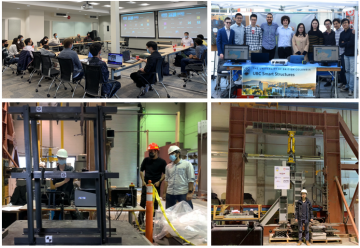
Background:
Xiao Pan is currently a Postdoctoral Research Fellow at the University of British Columbia (UBC). He obtained his Ph.D. degree (GPA 93/100) in Structural and Earthquake Engineering at UBC in 2022, MSc degree (1st class honors, distinction) from Imperial College London in 2017, and two Bachelor’s Degrees in Civil Engineering (1st class honors) from the National University of Ireland (Galway), and Jiangnan University (China) in 2016.
Research highlights and interests:
Dr. Pan’s research falls in smart and data-driven structural and earthquake engineering, with a focus on developing AI-empowered digital twin and automation methods in: 1) structural health monitoring, 2) innovative modular structures, and 3) robotic and modular construction. Specifically, these research domains involve the development and application of AI, nonlinear control, robots, computer vision, multi-sensor fusion, and innovative modular components and systems, through computer simulations, laboratory tests, and field validation. He has published over 20 technical articles including high-impact referred top journal papers at: Computer-aided Civil and Infrastructure Engineering (2023/2022 IF: 9.6/10.1, JCR Q1); Engineering Structures (2023/2022 IF: 5.5/5.6, JCR Q1), Journal of Building Engineering (2023/2022 IF: 6.4/7.2, JCR Q1), Earthquake Engineering & Structural Dynamics (2023/2022 IF: 4.5/4.1, JCR Q1). He has delivered over 30 technical presentations at international conferences, workshops, industrial meetings, and universities in Canada, China, the UK, the US, Japan, New Zealand, etc.
Xiao Pan is leading the AI & Smart Technologies team within the Smart Structures Group at UBC [1]. He has been leading multiple major research projects funded by the Natural Sciences and Engineering Research Council (NSERC) of Canada (totaled over $10 million). He has been responsible for organizing numerous meetings and events, workshops, and site visits for other research teams and industrial collaborators. Within the research team, he has been supervising/co-supervising Ph.D., Master’s, and undergraduate intern students in various numerical and experimental projects In addition, he has been providing technical feedback to the design and assessment of multiple landmark buildings and indigenous structures in Canada, the US, and China.

Selected referred journal publications:
[1]. Pan, X., Yang, T. Y. (2023). 3D vision-based bolt loosening assessment using photogrammetry, deep neural networks, and 3D point-cloud processing. Journal of Building Engineering.
[2] Pan, X., Xiao, Y., Yao, H., Yang, T. Y., & Adeli, H. (2023). Vision-based real-time structural vibration measurement through interactive deep-learning-based detection and tracking methods. Engineering Structures.
[3]. Pan, X., Tavasoli, S., Yang, T. Y. (2023). Autonomous 3D vision-based bolt loosening assessment using micro aerial vehicles. Computer-aided Civil and Infrastructure Engineering.
[4]. Tavasoli, S., Pan, X., Yang, T. Y. (2023). Real-time autonomous indoor navigation and vision-based damage assessment of reinforced concrete structures using low-cost nano aerial vehicles. Journal of Building Engineering.
[5] Pan, X., Yang, T. Y. (2022). 3D vision-based out-of-plane displacement quantification for steel plate structures using structure from motion, deep learning and point cloud processing. Computer-aided Civil and Infrastructure Engineering.
[6]. Xiao, Y., Pan, X., Yang, T. Y. (2022). Nonlinear backstepping hierarchical control of shake table using high-gain observer, Earthquake Engineering & Structural Dynamics.
[7]. Pan, X., & Yang, T. Y. (2021). Image-based monitoring of bolt loosening through deep-learning-based integrated detection and tracking. Computer-aided Civil and Infrastructure Engineering, 1–16.
[8]. Pan, X., Yang T.Y. (2020). Postdisaster image-based damage detection and repair cost estimation of reinforced concrete buildings using dual convolutional neural networks. Computer-aided Civil and Infrastructure Engineering, 35:495–510.
[9]. Pan, X., Málaga-Chuquitaype C (2020). Seismic control of rocking structures via external resonators. Earthquake Engineering and Structural Dynamics. 49:1180-1196. (Top Cited Article, Top Downloaded Article)
[10]. Yang, T. Y., Li, T., Tobber, L., & Pan, X. (2020). Experimental and numerical study of honeycomb structural fuses. Engineering Structures, 204, 109814.
Book Chapters:
Xiao, Y., Pan, X., Tavasoli, S., M. Azimi, Yang T.Y. “Autonomous inspection and construction of civil infrastructure using robots.” Automation in Construction toward Resilience, edited by Ehsan Noroozinejad Farsangi, Mohammad Noori, Tony T.Y. Yang, Paulo B. Lourenço, Paolo Gardoni Izuru Takewaki, Eleni Chatzi, Shaofan Li.
Awards:
2022 Top Cited Article Award, Journal of Earthquake Engineering & Structural Dynamics (top journal)
2020-2022 President’s Academic Excellence Initiative PhD Award, UBC, Canada.
2019 Civil Engineering PhD Excellence Award, UBC, Canada.
2018-2022 International Tuition Award, UBC, Canada.
2018-2022 Ph.D. fellowship, UBC.
2016 Tobin Gold Medal, Tobin Consulting Engineers, Ireland.
2016 Ward and Burke Medal, Ward & Burke Construction Ltd, Ireland.
2016 University Research Scholarship for Undergraduates, NUI Galway, Ireland.
2015-2016 First Class Honours Award, NUI Galway, Ireland.
2015 RPS Consulting Engineers Prize, RPS Group, Ireland.
2014 University Tuition Fees Scholarship (40% deduction), NUI Galway, Ireland.
2014 China’s National Scholarship for Outstanding Undergraduates, Educational Ministry of China.
2013/2014 University First-prize Award to Excellent Undergraduate Students, Jiangnan University, China.